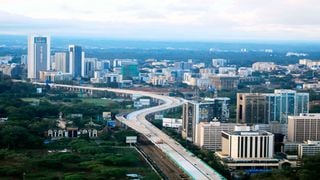
A view of the Nairobi Expressway crisscrossing Nairobi City in this photo taken on December 25, 2021.
| File | Nation Media GroupNews
Premium
Kenya's wins and losses, the cancer of corruption and other painful economic lessons
The defunct Kenya Posts and Telecommunications Corporation (KPTC), which was one of the biggest employers in Kenya’s history, was privatised in 2007.
In what ranks as one of the most expansive retrenchment programmes ever, the corporation cut its staff from 17,480 to 7,154. Today, 25 years later, Telkom Kenya – its successor – has a workforce of just about 2, 000 employees.
According to a staff audit that was conducted in August 2005 as part of preparations for the privatisation of the corporation, it was found to have employed 1,009 watchmen, 1,028 porters and 1,115 messengers. The number of university graduates on its payroll was a paltry 399.
Another big employer in the economy at the time, the Kenya Railways Corporation, was also privatised in April 2006 under a concession deal to a South African businessman in what turned out to be one of the most socially disruptive privatisation transactions in history.
Some 6,000 employees were sent home. Hardly a year after, in October 2007, the South Africans sent home another 440 employees without severance pay.
If I wanted to summarise what has happened to the economy 60 years after Independence, I would say that the most telling shortcoming in the country’s development strategies has been the failure of successive regimes to register the singular importance of the unemployment problem.
In all the major policy documents, the gravity of the problem was acknowledged. At every opportunity, the determination to resolve the problem was proclaimed. But this was never really reflected in actual policies, especially at operational levels.
The policy of automatic employment of university graduates and diploma holders from other government training institutions was abandoned under the regime of structural adjustment programmes in the ‘80s. A rising proportion of the workforce is in low-value and relatively insecure jobs.

The defunct Kenya Posts and Telecommunications Corporation (KPTC), which was one of the biggest employers in Kenya’s history, was privatised in 2007. In what ranks as one of the most expansive retrenchment programmes ever, the corporation cut its staff from 17,480 to 7,154. Today, 25 years later, Telkom Kenya – its successor – has a workforce of just about 2, 000 employees.
At Independence in 1963, Kenya’s basic physical and institutional infrastructure, the educational levels of its population and the depth of the private sector were all considered among the best in Africa.
Yet, long-term economic trends have been disappointing. The average GDP growth rate declined from 7 per cent in the 1970s to 2.2 per cent between 1990 and 1997, falling below the average population growth rate of 2.9 per cent. Kenya’s 2.2 growth rate in the 1990s does not compare favourably with those of Tanzania (4 per cent) and Uganda (5.6 per cent).
Low-paying jobs
Despite collecting close to 13 per cent of GDP in taxes, the country has been unable to provide and maintain the basic economic and social infrastructure to support private investments. More than ever before, many Kenyans are having to put up with low-paying, low-quality jobs.
As a daily commuter in Nairobi, most of the workers in matatus or buses going to work in the morning will be hair stylists, fitness instructors, club bouncers, employees of companies offering cleaning services, and people who work where cars are washed using pressure machines.
A good number will be motor vehicle mechanics, workers in M-Pesa outlets, or employees of call centres, telephone repair shops or shops offering photocopying and document binding services. M-Pesa shops and car-wash businesses have sprouted in every corner of the capital.
In the Central Business District, the formerly ubiquitous shops owned by Kenyan Indians are disappearing and being replaced by 10 by 10-foot kiosks selling un-customed clothes, footwear, mobile phones and computers, which invariably will have been brought into the country through Kismayu or Eldoret Airport. Every other town has a “Garissa Lodge” — jargon for shops selling un-customed goods.
While policymakers reel out statistics showing how hundreds of thousands of jobs are created in the informal sector, the issue of poor-quality jobs and the fact that the economy has lost the capacity to create decent opportunities for the people is hardly articulated. Do we even pause to ask about the quality of jobs in the informal sector - working conditions, working hours, or the return on effort?

Despite collecting close to 13 per cent of GDP in taxes, the country has been unable to provide and maintain the basic economic and social infrastructure to support private investments. More than ever before, many Kenyans are having to put up with low-paying, low-quality jobs.
Informal sector
Work in the informal sector is characterised by maximum physical exertion, inhuman working hours and meagre returns on effort.
What can you say of an able-bodied hawker, who walks hours on end from bar to bar in Nairobi’s Eastlands, his only stock of capital being a handful of second-hand sports shoes and T-shirts? It is just another form of joblessness.
Even though the evidence may be anecdotal, there would appear to be a direct relation between the informalisation of the economy — the explosive growth of slums, the matatu culture, the hawking menace — and urban insecurity. The policy must seek to eliminate this sector so that we can move citizens away from the beastly working conditions to sectors that can offer decent and durable jobs.
There are several other trends I find worrisome. We have done very well in terms of jerking up infrastructure spending. We have a fairly strong financial sector, but the growth of public sector debt as a percentage of GDP is just too high. At 60 years as a free nation, it is an opportune time to look at the changes and plot the major trends taking place in the country’s economic landscape.
A comprehensive analysis of the broad economic trends would not fit in this space. Cramming this space with humdrum numbers about GDP growth rates, fixed capital formation, labour productivity, inflation trends, exchange rate trends or any other measures of quantitative development will only obscure the enduring trends in the economy.
What is possible is the flagging of broad trends about quality of life issues and pointing out the fundamental changes happening under our very noses but which we refuse to notice or accept as the economic realities of our time.
A few trends stick out. The main long-term trend in the economy has been the shift away from manufacturing to deindustrialisation that manifests in the consistent decline in manufacturing value added to GDP from double-digit levels in the 1960s to the current 7 per cent.
Second, finance, insurance, real estate and telecommunications, and retail consumption have become the most dynamic and the only growing parts of the economy. Private sector investment and growth remain relatively subdued as manifested in stagnant private sector credit growth to GDP.

At Independence in 1963, Kenya’s basic physical and institutional infrastructure, the educational levels of its population and the depth of the private sector were all considered among the best in Africa.
At 60, Kenya holds the top spot as the region’s financial hub. It leads in all segments, including cross-border lending, foreign equities turnover, foreign exchange turnover, insurance premiums, fund management and private equity.
Third, although public sector funding of infrastructure - roads, ports, railways, electricity and fibre optic cables - has been substantial, the domination of infrastructure by Chinese state banks and contractors who must be paid by Chinese lenders at source has led to a situation where most infrastructure spending is the kind that doesn’t inject liquidity into the macroeconomy.
Fourth, public finances are in the deep red, limiting the ability of the government to use fiscal policy. While the growth rates the country has been posting have been respectable, that growth has been increasingly debt-financed and in unproductive sectors.





